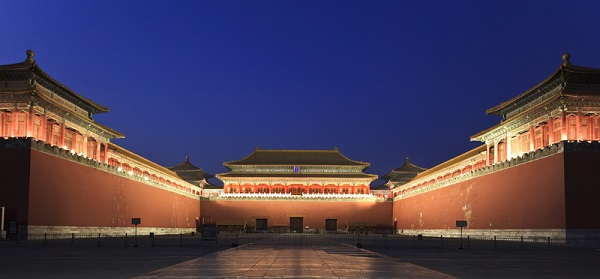

In 1978, China’s economy witnessed dramatic changes due to the government’s major economic reforms. The government allowed the formation of rural businesses or ownerships. It invested in educating the workforce, encouraged the development of private business and increased industrial production. The government of China also created four special economic zones or SEZs to attract investment from foreign countries and to start importing high-technology goods into China. One of the important economic reforms was to decentralise economic control and allow the implementation of free market principles. China’s economic rise led it to an annual GDP (Gross Domestic Product) of 9.5% in the year 2018.

Beijing, the capital city of China
Description-Beijing Cityscape, which is one of the most industrialised cities in China
The reform in the rural sector helped in expanding ownership of property in the rural areas. More people started non-agricultural businesses. An increase in the price of agricultural products led to more profit for farmers, which in turn increased agricultural productivity and efficient use of labour. Thus, people shifted from traditional farming to more improved, value-added and technologically improved manufacturing and production. Farmers started investing more in commercial farm products like sugarcane and cotton. This helped to reduce poverty in China.
The huge production of cotton in China led to an increase in the Chinese textile industry. Through its “open door policy” the country also began exporting its textiles to major parts of the world, thus making a significant impact on the world economy.
China’s initiative to educate its labour force led it to provide subsidies to around 70% of schools and skill development programs during the 1980s. It also made policies that made it mandatory to attend school for nine years. This schooling would also include vocational training. This policy increased the number of graduates to almost 1 million during the 1990s.
China’s involvement with the Internal Monetary Fund, World Bank and the Asian Development Bank in the 1990s helped China to build newer economic connections. In 2001, China also joined the World Trade Organization. These connections helped China to become a major producer in the world, challenging Japan.
During the 1990s when the internet was flourishing in the United States, companies like Apple, HP, etc were in urgent need of skilled labour. This is when China created a policy named ‘Conditional Foreign Investment’. According to this policy, Foreign firms can create partnerships with Chinese domestic firms, but they are required to share their technologies with the Chinese firms. This led to an improvement in Chinese technology and production. It also helped China to grow its IT business, as a result of which the Chinese service industry rose to 54% in 2019.
Another important economic strategy is President Xi-Jinping’s ‘Go Global Strategy’ which allowed the expansion of business enterprises by encouraging them to invest in the international market.
Economic reforms implemented by the Chinese government have made China a major partner of commerce to the United States. It is also America’s third-largest market for export and the country’s leading merchandise trading partner.
But despite this, China’s growing economic influences are considered a major threat to the United States. The major reason for this is that China’s economic progress has also increased its regional importance and power. This regional dominance is slowly inclining towards hegemony and is creating huge security concerns for both the US and the neighbouring countries of China.
China's ‘Belt and Road’ initiative is said to influence the weaker Indo-Pacific countries.
This led to the String of Pearls hypothesis of the United States, where the researchers have referred to the network of Chinese commercial and military activities along the sea lines of China to that of Africa.
Apart from this economic progress, China has shown deep interest in the environmental aspects of the world, especially in the case of major environmental changes including climate change. China has organised the National Coordination Committee on Climate Change in 2003. It also formed China's National Climate Change Programme in 2007.
China also signed the Comprehensive Test ban Treaty and Nuclear Suppliers Group in 1992. According to China’s economic activities and global performance in the world, it is necessary to note that China is spreading its influence in every major field, right from economy to technology to environment to politics. Its silent rise and military modernization program have generated many geopolitical debates around the implications they have created and are about to create. Therefore, it can be concluded that China’s 1978 economic reforms played a major role in creating China’s strong productivity growth. This policy created a base for newer economic policies and improvements. Many researchers see China’s economic growth being a major threat to the economy of the United States and the international trading system.
Q1. What is meant by the ‘Belt and Road Initiative’?
Ans. The ‘Belt and Road Initiative’ was implemented by the Government of China in 2013 to expand China’s economic and political power. Through this, China would create huge infrastructures in around 150 countries and international organisations.
Q2. What is the ‘Go Out Policy’ of China?
Ans. The ‘Go Out Policy’ is the other name of the Going Global Policy. It was passed in 1999 by the Chinese government. Within this policy, the Chinese government introduced several schemes together with the China Council for the Promotion of International Trade to encourage and help Chinese domestic companies to develop a global strategy of investment in the international market.
Q3. Was China part of the Kyoto Protocol?
Ans. Yes, China was very much part of the Kyoto Protocol. The Protocol was signed by delegates from 150 countries on December 11, 1997. The protocol was designed to encourage industrialised countries in the world to reduce the emission of greenhouse gases. This treaty which operates under the United Nations Framework Convention on Climate Change is an important treaty aimed to monitor and reduce global warming.